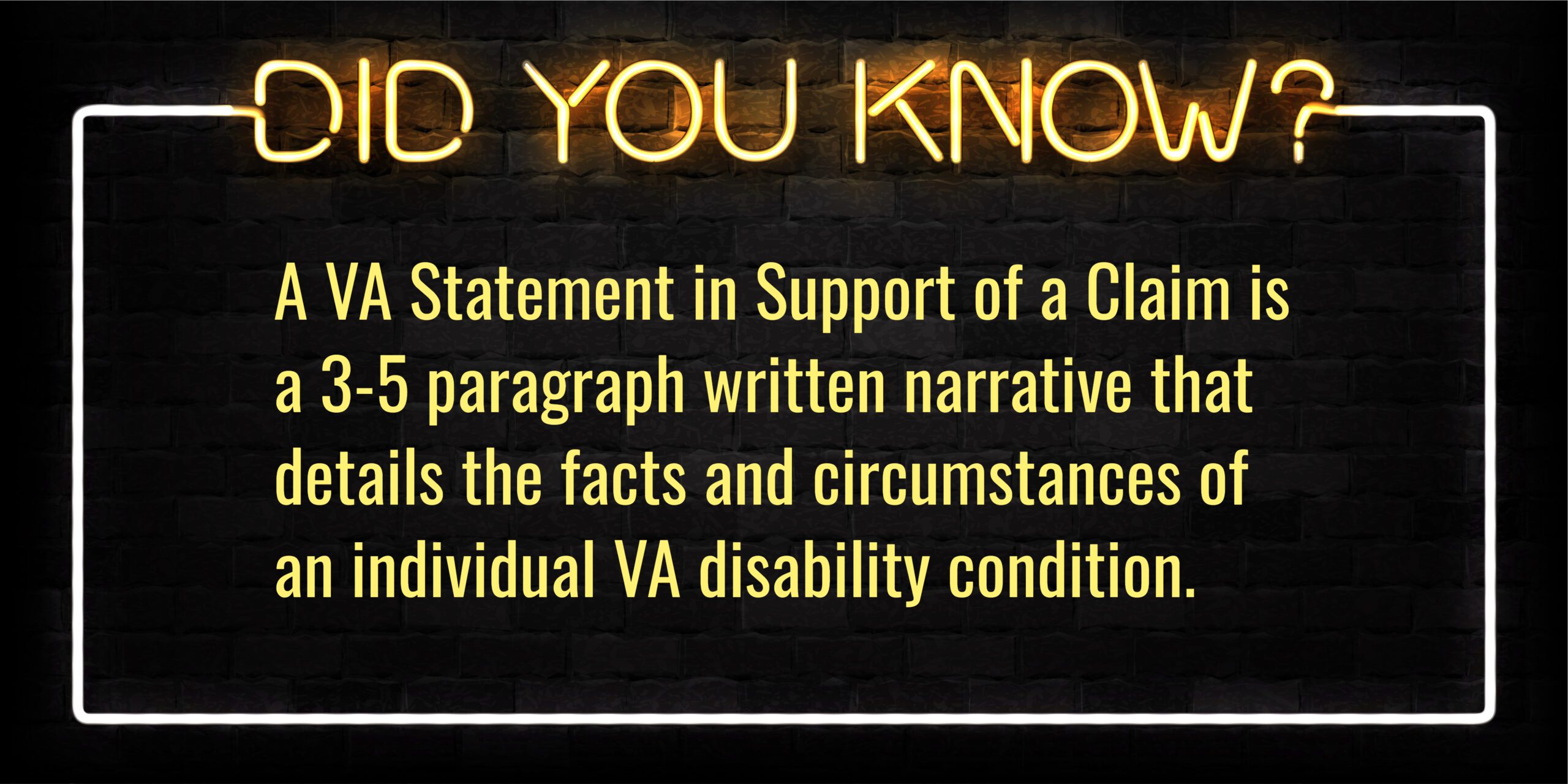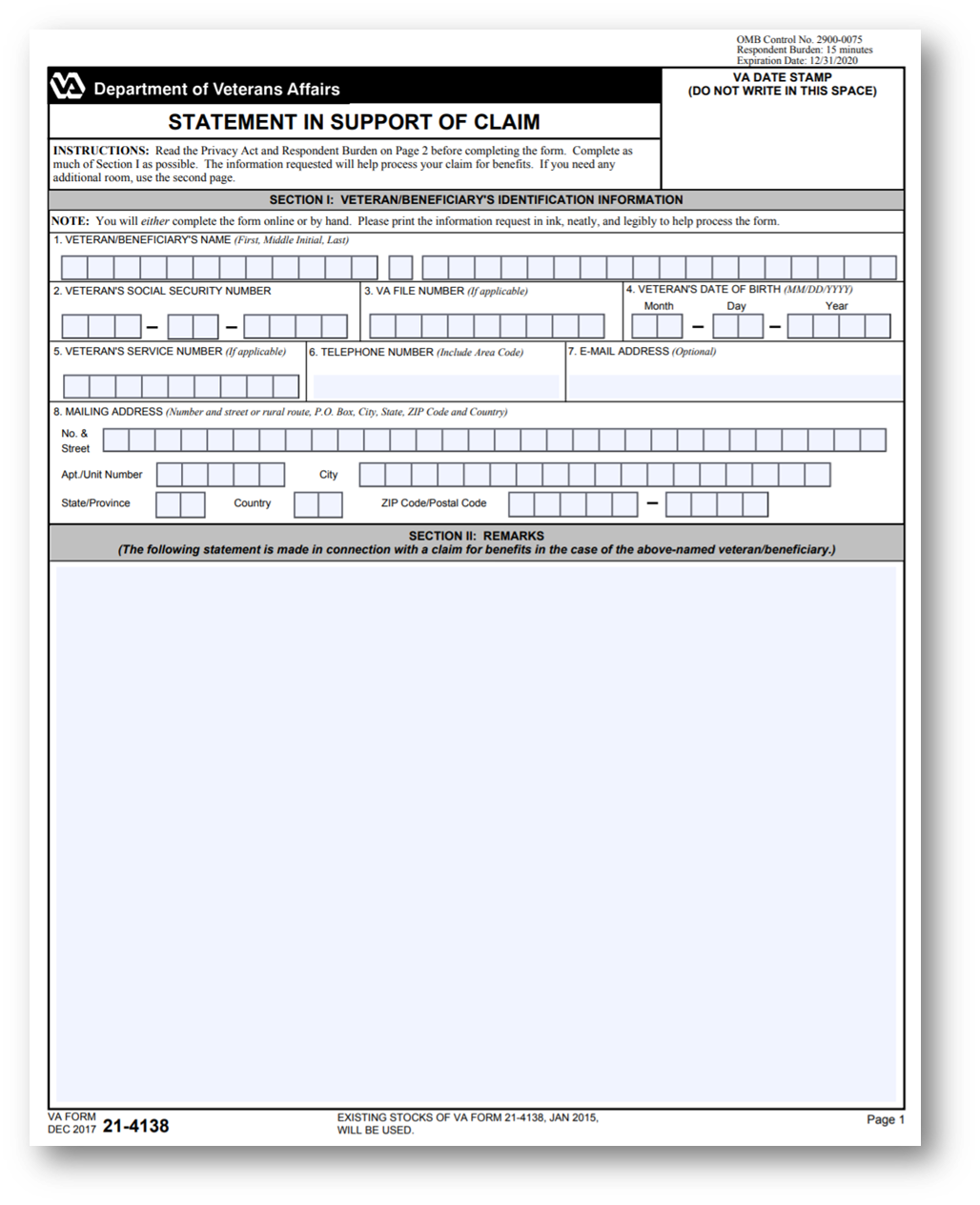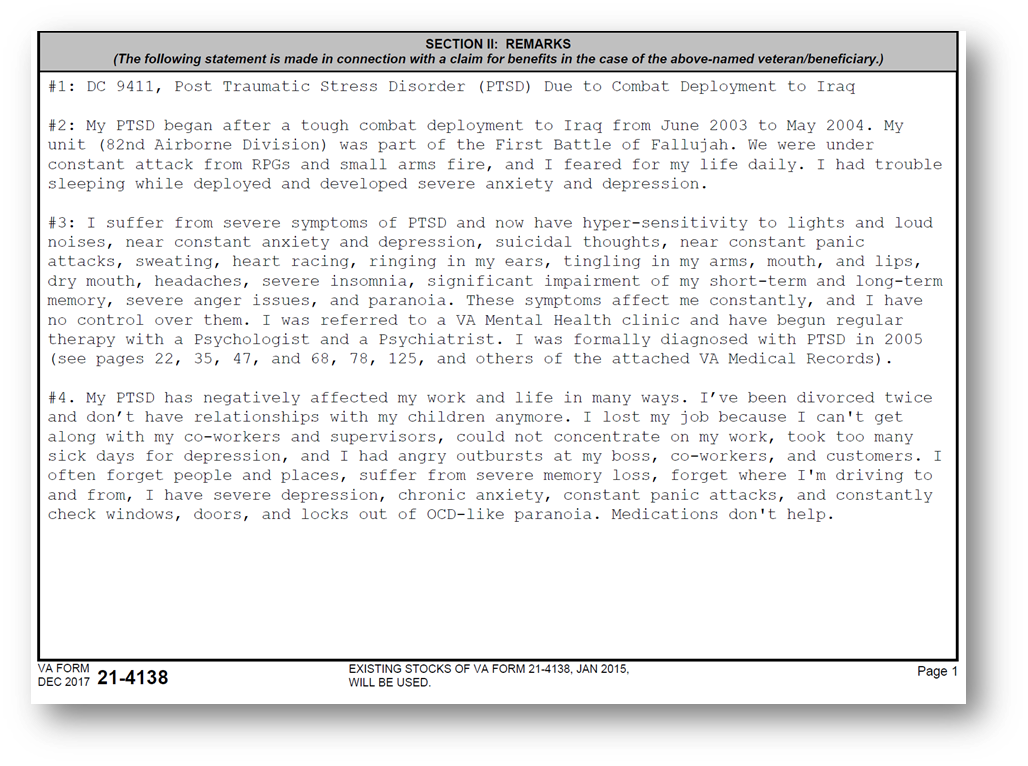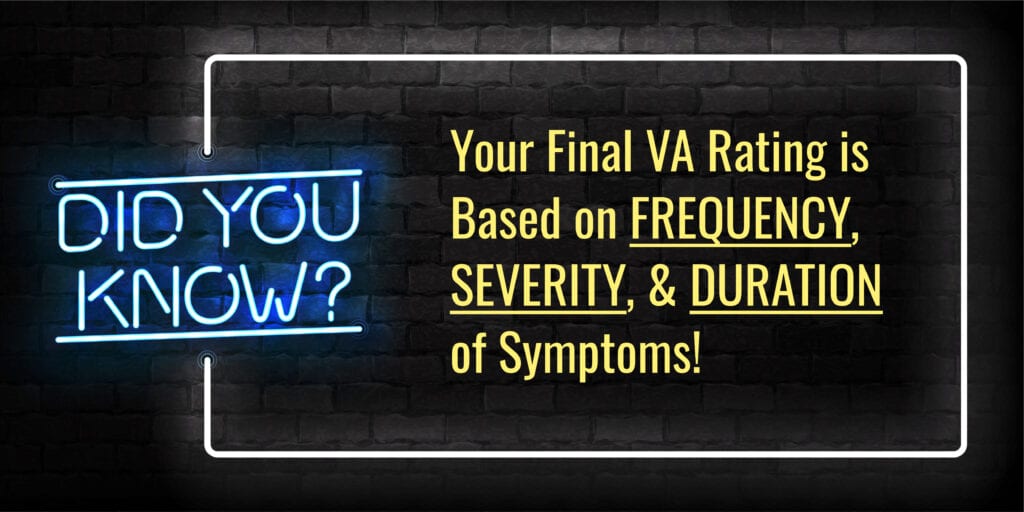Looking for Expert-Level VA Claim Answers?📱Call Us Now! 737-295-2226
In today’s high-value blog post, I’m going to share a real VA Statement in Support of Claim Example to include our 4-step process used by thousands of veterans so you can write powerful personal statements to support your VA disability claims.
What’s the bottom line?
A competent and credible personal statement in support of a claim can be the linchpin between winning and losing your VA disability claim and getting the appropriate VA rating for your disability.

Personal statements are immensely powerful and important for your VA claim strategy and should be written carefully.
You must be open, honest, and uncomfortably vulnerable when writing your VA statements in support of a claim.
Think LESS is MORE.
Keep it short and sweet.
And you do NOT need to describe every detail.
A VA Statement in Support of Claim should be 3-5 paragraphs max.
VA Raters are very busy and don’t have time to read a novel.
But first things first: You might be wondering what the heck is a Statement in Support of a Claim (VA Form 21-4138)?
- What is a VA Statement in Support of a Claim?
- Statement in Support of a Claim Sample: 4 Critical Sections Explained
- Should I Write a Statement in Support of a Claim for Each Disability Condition I’m Claiming?
- How to Write a Powerful VA Statement in Support of Claim (4-Step Process)
- Step #1: List the Name of the Disability You’re Claiming in the First Section of the VA Form 21-4138
- VA Personal Statement Examples Step #2: Explain the Approximate Timeframe Your Disability Began Along with Why It Should Be Service Connected (or Why Your VA Rating Should Be Increased for Conditions Already Service Connected)
- Statement in Support of Claim Sample Step #3: List the Current Symptoms of Your Disability in Terms of Frequency, Severity, and Duration Over Time
- How to Write a VA Statement in Support of a Claim Step #4: Explain How the Disability Negatively Impacts your Work, Life, and Social Functioning.
- How to Write a Winning VA Statement in Support of Claim!
- VA Statement in Support of Claim Example
- Deserve an Increase in Your VA Disability? We Got You Covered!
- About the Author
What is a VA Statement in Support of a Claim?

A VA Statement in Support of a Claim is a 3-5 paragraph written narrative that details the facts and circumstances of an individual VA disability condition.
Personal statements can be very powerful in filling in any gaps between your military service and present day, including things like service treatment records, doctor visits for treatment (or lack thereof), severity of your symptoms over time, and how your disability is negatively affecting your work, life, and social functioning.
Are you STUCK, FRUSTRATED and UNDERRATED?
You are not alone! We are Veterans helping Veterans!
Become an Elite Member and work with our Veteran Coaches to get the rating you deserve!
Statement in Support of a Claim Sample: 4 Critical Sections Explained
The best VA Statements in Support of a Claim include the following 4 sections with specific examples tailored to you:
#1. List the Name of the Disability You’re Claiming in the First Section of the VA Form 21-4138
#2. Explain the Approximate Timeframe Your Disability Began Along with Why It Should Be Service Connected (or Why Your VA Rating Should Be Increased for Conditions Already Service Connected)
#3. List the Current Symptoms of Your Disability in Terms of Frequency, Severity, and Duration Over Time
#4: Explain How the Disability Negatively Impacts your Work, Life, and Social Functioning (Use a Couple Examples).
The official VA Form 21-4138 is still the preferred document to use to write a personal statement or if you want to submit a VA “Buddy Statement” from someone with firsthand knowledge of the facts and circumstances to support your VA disability claims.

Should I Write a Statement in Support of a Claim for Each Disability Condition I’m Claiming?
Yes!
In our experience, you should write a detailed personal statement for each disability you’re claiming.
For example, let’s say you’re going to file one VA disability claim with three separate conditions: An increase for your service-connected PTSD, an increase for your service-connected GERD, and a new secondary condition for Migraines secondary to Tinnitus.
You should personally write three separate VA Statements in Support of a Claim for each disability condition.

Statement #1: Statement in Support of a Claim to Increase Service-Connected PTSD VA Rating, which should explain how your PTSD limits or affects your work, life, and social functioning, to include your current mental health symptoms, and why you should have a higher rating.
Statement#2: Statement in Support of a Claim to Increase Service-Connected GERD, which should explain how your GERD limits or affects your work, life, and social functioning, to include your current GERD and acid reflux symptoms, and why you should have a higher rating.
Statement #3: Statement in Support of a Claim for Migraines Secondary to Tinnitus, which should explain why you think your Migraines were caused or aggravated by your Tinnitus, how your Migraines limit or affect your work, life, and social functioning, to include your current Migraine symptoms.
How to Write a Powerful VA Statement in Support of Claim (4-Step Process)

Before we begin, make sure to download the official VA Form 21-4138 Statement in Support of a Claim and save it to your computer.
Step #1: List the Name of the Disability You’re Claiming in the First Section of the VA Form 21-4138
In part one, you’ll want to list the name of the VA disability condition you’re claiming.
I recommend that the name of the condition matches the actual medical diagnosis in your medical records.
For example, if you’re a first-time filer of PTSD, you would name the disability in the header as follows:
DC 9411, Post Traumatic Stress Disorder (PTSD) Due to Combat Deployment to Iraq
Expert Tip: Insert the Diagnostic Code (DC) of the condition you’re claiming from CFR Title 38, Part 4, Schedule for Rating Disabilities.
VA Personal Statement Examples Step #2: Explain the Approximate Timeframe Your Disability Began Along with Why It Should Be Service Connected (or Why Your VA Rating Should Be Increased for Conditions Already Service Connected)
In part two of your Statement in Support of a Claim, you should explain the approximate timeframe (month and year) that your disability condition and symptoms began.
If you’re filing for an increase on a disability that’s already service connected, go ahead and explain how long you’ve been service connected and why you’re filing for an increase, paying close attention to the frequency, severity, and duration of your symptoms over time.
If you’re filing for direct service connection, explain to the VA Rater the in-service incident, injury, or disease that led to the development of your disability.
For example, if you’re claiming PTSD due to a combat deployment, be sure to explain this to include any PTSD Stressor Events (e.g., you feared for your life and safety) to the VA Rater in your personal statement, along with the location, month, and year.
If you’re filing for secondary service connection, explain to the VA Rater why you think a current service-connected disability caused or aggravated the new secondary disability condition.
Let’s say you’re filing for Migraines secondary to Tinnitus.
You could write something such as:
“I’ve had service-connected Tinnitus since 2006. The near-constant ringing in my ears has led me to develop severe Migraine Headaches roughly 2-4x per month. Because of this, I think my Migraines are secondary to Tinnitus. I’ve also included an Independent Medical Opinion from a private provider along with medical research to support this conclusion.”
Expert Tip: You want to explain the “Nexus” (e.g., why you think the condition should be service connected) to the VA Rater very clearly in two sentences or less. List the page numbers in your records where the VA Rater can find the condition quickly.
Statement in Support of Claim Sample Step #3: List the Current Symptoms of Your Disability in Terms of Frequency, Severity, and Duration Over Time

In part three, you should list the current symptoms of the disability you’re claiming.
Explaining your current disability symptoms in detail is critically important because VA disability ratings depend upon your frequency, severity, and duration of symptoms over time.
If you suffer from severe symptoms of PTSD that cause major impacts, be sure to write down all the symptoms with examples so the VA Rater gets an accurate picture of your approximate symptoms and level of impairment.
Here is an example of how to write this section:
I suffer from severe symptoms of PTSD and now have hyper-sensitivity to lights and loud noises, near-constant anxiety and depression, suicidal thoughts, near-constant panic attacks, sweating, heart racing, ringing in my ears, tingling in my arms, mouth, and lips, dry mouth, headaches, severe insomnia, significant impairment of my short-term and long-term memory, severe anger issues, and paranoia. These symptoms affect me constantly, and I have no control over them. I was referred to a VA Mental Health clinic and have begun regular therapy with a Psychologist and a Psychiatrist. I was formally diagnosed with PTSD in 2006 (see pages 22, 35, 47, and 68 of the attached VA Medical Records).
Expert Tip: Pay close attention to the symptoms based on the rating criteria of the condition you’re claiming from CFR Title 38, Part 4, Schedule for Rating Disabilities. You should have a basic idea of what your eligible for by law by looking at the VA rating criteria for your disability.
How to Write a VA Statement in Support of a Claim Step #4: Explain How the Disability Negatively Impacts your Work, Life, and Social Functioning.
In part four, you should explain how the disability negatively affects your work, life, and social functioning.
A best practice is to explain at least two specific examples of how your disabilty is limiting or affecting you in negative ways.
My PTSD has negatively affected my work and life in many ways. I’ve been divorced twice and don’t have relationships with my children anymore. I lost my job because I can’t get along with my co-workers and supervisors, could not concentrate on my work, took too many sick days for depression and anxiety, and I had angry outbursts at my boss, co-workers, and customers. I often forget people and places, suffer from severe memory loss, forget where I’m driving to and from, I have severe depression, chronic anxiety, constant panic attacks, and constantly check windows, doors, and locks out of OCD-like paranoia. I’ve tried vet centers, medications, mindfulness, etc., and receive little to no relief.
How to Write a Winning VA Statement in Support of Claim!
In this video, I show you “How to Write a Winning VA Statement in Support of Claim” using our simple 4-step process with examples.
I also share a real VA Statement in Support of Claim Example with on-screen tips, strategies, and lessons learned.
***VA Statement in Support of Claim – Video Timestamps & Resources***
⏩ 00:00 Brian Reese VA Insider Welcome Message
⏩ 02:12 VA Disability Benefits Basic Eligibility Explained!
⏩ 05:36 Why Write a VA Statement in Support of Claim?
⏩ 07:44 The 4 Essential Parts to a Winning VA Personal Statement
⏩ 16:20 VA Ratings Depend on Frequency, Severity, and Duration of Symptoms
⏩ 22:08 VA Statement in Support of Claim Example for PTSD
⏩ 24:00 Statement in Support of Claim Example for Migraines (Headaches)
⏩ 25:20 VA Claims Insider Elite Program Overview
⏩ 37:22 Unlock FREE VA Disability Resources at: https://vaclaimsinsider.com/
⏩ 42:17 How Does VA Claims Insider Work?
VA Statement in Support of Claim Example

Here’s a real VA Statement in Support of Claim Example for Migraine (Headaches) with sections from the VA Form 21-4138.
This was a re-evaluation, and the Veteran was already service connected at 30% for Migraines but didn’t feel an increase was warranted to the higher VA rating level of 50% for Migraines.
Statement in Support of Claim Sample
- #1. DC 8100, Migraine Headaches
- #2. My headaches have remained largely the same (static/permanent) with occasional increases and decreases in severity. My headaches have been service-connected since 2012.
- #3. When I’m having a migraine, I experience pain on both sides of my head, which last anywhere from 30 minutes to 1-2 hours. These episodes occur once every 2 weeks on average. I take Tylenol OTC and Motrin OTC in varying doses to help with the pain. I do take frequent naps 3-5x per week, to include 15-to-30-minute rest periods during the workday, especially when the headaches occur. I also practice regular mindfulness meditations and calming music to include noise-canceling headphones.
- #4. I’ve worked from home since 2014, which helps me maintain control of my surroundings to include the environment, sounds, lights, space, etc. My migraines do affect my work as I’m less productive due to napping and frequent breaks.
Deserve an Increase in Your VA Disability? We Got You Covered!
At VA Claims Insider, we help fellow Veterans celebrate LIFE CHANGE by getting you the VA disability rating and compensation you deserve by law.
- VA Claims Insider is the #1 most trusted name in VA disability claims.
- 25,000+ disabled veterans served in our membership programs since 2016.
- 30% average VA rating increase for veterans who complete our #1 rated Elite program.
- Employs 215 teammates; comprised of 74 veterans and 16 military spouses.
- 4.7/5.0 average rating out of 4,500+ total reviews; over 4,000 5-star reviews.
If you’re ready to secure the VA disability claim rating and compensation you deserve for your honorable service to our nation, simply click the button below now to start our FREE 3-step intake process (you’ll hear from a Veteran Coach (VC) within minutes).
Deserve a HIGHER VA Rating? WE CAN HELP.
Join our premier education-based membership program, VA Claims Insider Elite, connect with an expert-level Veteran Coach (VC) within minutes, and finally get the rating you deserve. Click the button below to get started.
About the Author

Brian Reese is a VA disability expert, former military officer, and founder of VA Claims Insider – “The Most Trusted Name in Education-Based Resources for Veterans.”
His frustration with the 8-step VA disability claims process led him to create “VA Claims Insider,” which provides U.S. military veterans with tips, strategies, and lessons learned to win their VA disability compensation claim in less time.
Brian is also the CEO of Military Disability Made Easy, which is the world’s largest free searchable database for all things related to DoD disability and VA disability, and has served more than 6,000,000 military members and veterans since its founding in 2013.
He is a former active duty Air Force officer with extensive experience leading hundreds of individuals and multi-functional teams in challenging international environments, including a combat tour to Afghanistan in 2011 in support of Operation ENDURING FREEDOM.
Brian is a Distinguished Graduate of Management from the United States Air Force Academy, Colorado Springs, CO and he holds an MBA from Oklahoma State University’s Spears School of Business, Stillwater, OK, where he was a National Honor Scholar (Top 1% of Graduate School class).




